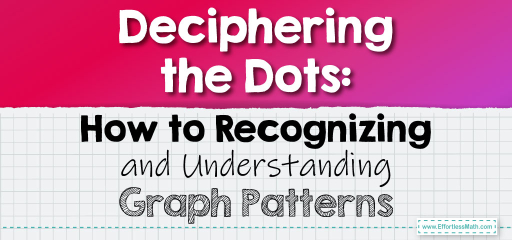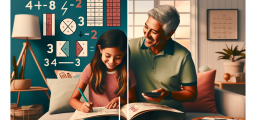Deciphering the Dots: How to Recognizing and Understanding Graph Patterns

Step-by-step Guide to Recognizing and Understanding Graph Patterns:
4. Scatter Plots with No Clear Pattern:
If the points on a scatter plot seem randomly distributed with no discernible trend, it indicates that there might be no correlation between the variables.
5. Clusters:
Groups of data points clustered together can indicate specific categories or groups within the data.
6. Gaps or Outliers:
A point or points that lie far away from the general trend are called outliers. They can be due to anomalies, errors, or genuinely exceptional cases.
7. Plateaus:
A flat section on a graph indicates that a variable has stabilized and is not currently changing.
Example 1:
A graph showing the growth of a bacterial culture over time might start flat (lag phase), then curve upwards sharply (exponential growth phase), and finally plateau (stationary phase).
The Absolute Best Book for 5th Grade Students
Example 2:
A graph plotting daily temperatures over a year would show an oscillating pattern, with temperatures rising in the summer months and falling in the winter.
Practice Questions:
1. If a graph shows the amount of money saved over time and it forms a straight line going up, what does this indicate?
2. A company plots its sales over a year, and the graph shows a U-shaped curve. What might this suggest about their sales?
A Perfect Book for Grade 5 Math Word Problems!
Answers:
1. The person is saving money at a constant rate.
2. The company might have had low sales at the beginning and end of the year but saw a significant increase in the middle of the year.
The Best Math Books for Elementary Students
Related to This Article
More math articles
- Top 10 Algebra 1 Books in 2026 (Expert Recommendations)
- The College Mathematics Exam Overview
- Other Topics Puzzle – Challenge 98
- Best SAT Math Prep Books
- Top 10 3rd Grade PARCC Math Practice Questions
- What is the Side Splitter Theorem? A Complete Introduction and Exploration
- Overview of Middle-Level SSAT Mathematics Test
- How to Create a Proportion? (+FREE Worksheet!)
- How to Pass TSI Test: Top Tips and Key Tactics
- Perimeters and Areas of Rectangles


























What people say about "Deciphering the Dots: How to Recognizing and Understanding Graph Patterns - Effortless Math: We Help Students Learn to LOVE Mathematics"?
No one replied yet.